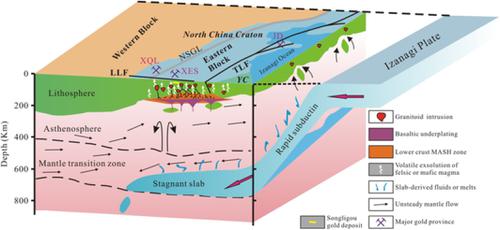当前位置:
X-MOL 学术
›
Resour. Geol.
›
论文详情
Our official English website, www.x-mol.net, welcomes your
feedback! (Note: you will need to create a separate account there.)
Geochronology and fluid source constraints of the Songligou gold‐telluride deposit, western Henan Province, China: Analysis of genetic implications
Resource Geology ( IF 1.1 ) Pub Date : 2019-12-25 , DOI: 10.1111/rge.12228 Peng Wang 1 , Wei Jian 2 , Jing‐Wen Mao 1, 2 , Hui‐Shou Ye 2 , Wei‐Wei Chao 1 , Yong‐Fei Tian 2 , Jian‐Ming Yan 3
Resource Geology ( IF 1.1 ) Pub Date : 2019-12-25 , DOI: 10.1111/rge.12228 Peng Wang 1 , Wei Jian 2 , Jing‐Wen Mao 1, 2 , Hui‐Shou Ye 2 , Wei‐Wei Chao 1 , Yong‐Fei Tian 2 , Jian‐Ming Yan 3
Affiliation

|
The Songligou gold‐telluride deposit, located in Songxian County, western Henan Province, China, is one of many gold‐telluride deposits in the Xiaoqinling‐Xiong'ershan district. Gold orebodies occur within the Taihua Supergroup and are controlled by the WNW F101 Fault, and the fault was cut across by a granite porphyry dike. Common minerals in gold orebodies include quartz, chlorite, epidote, K‐feldspar, calcite, fluorite, sericite, phlogopite, bastnasite, pyrite, galena, chalcopyrite, sphalerite, tellurides, gold, bismuthinite, magnetite, and hematite, and pyrite is the dominant sulfide. Four mineralization stages are recognized, including pyrite‐quartz stage (I), quartz‐pyrite stage (II), gold‐telluride stage (III), and quartz‐calcite stage (IV). This work reports the Rb–Sr age of gold‐telluride‐bearing pyrite and zircon U–Pb age of granite porphyry, as well as S isotope data of pyrite and galena. The pyrite Rb–Sr isochron age is 126.6 ± 2.3 Ma (MSWD = 1.8), and the average zircon U–Pb age of granite porphyry is 166.8 ± 4.1 Ma (MSWD = 4.9). (87Sr/86Sr)
i values of pyrite and δ34S values of sulfides vary from 0.7104 to 0.7105 and −11.84 to 0.28‰, respectively. The obtained Rb–Sr isochron age represents the ore formation age of the Songligou gold‐telluride deposit, which is much younger than the zircon U–Pb age of the granite porphyry. Strontium and S isotopes, together with the presence of bastnaesite, suggest that the ore‐forming fluid was derived from felsic magmas with input of a mantle component and subsequently interacted with the Taihua Supergroup. Tellurium was derived from metasomatized mantle and was related to the subduction of the Shangdan oceanic crust and Izanagi plate beneath the North China Craton (NCC). This deposit is a part of the Early Cretaceous large‐scale gold mineralization in east NCC and formed in an extensional tectonic setting.
更新日期:2019-12-25











































 京公网安备 11010802027423号
京公网安备 11010802027423号